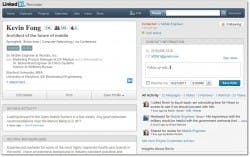LinkedIn is introducing something it calls “Targeted Updates” and “Follower Statistics” with a select group of early release partners, kind of like it tested the “Pipeline” product with a charter group.
First, let’s talk Pipeline. Talent Pipeline. 
That’s the LinkedIn product for “CRM” — sometimes considered “candidate relationship management” in the recruiting field. We talked to some of the charter members of the testing group. Johanna Danaher and Pfizer, for example, are heavy LinkedIn users and Pipeline testers, and like that it’s more customizable than applicant tracking systems tend to be.
Jim Schnyder headed up Pepsi’s rollout of Pipeline, and has worked LinkedIn on improvements to the product. He says it’s a “game-changer” and writes:
Here’s an example of how I foresee using this tool in future. Let’s say I routinely recruit accountants in the Boulder, Colorado area. I can run a targeted search using the Linked Recruiter technology to get to that population. Separately, I can network outside of LinkedIn using any of my other favorite sources, gather leads in an excel template, and upload them to Talent Pipeline. Many of them will already have LinkedIn profiles, and the system will automatically match them. Others won’t, and that’s OK; LinkedIn will create a record that lives in my system only (not on the public LinkedIn platform).
As time goes by, I can return to this pool, keep in touch with them, and when I’m hiring another CPA in the Boulder area nine months from now, I know exactly where to start. I can filter within that group and selectively send out messages, more or less tapping them on the shoulder to see if they’re interested or know of someone … I can imagine this same technology being used to help us set up all sorts of similar talent pools – drawing on graduating classes from targeted business schools/colleges, for example, and other populations that can be hard to keep in touch with as they change jobs, locations and even names.
The New Tools
Products called “Follower Statistics” and “Targeted Updates” are another addition that LinkedIn is testing out right now. LinkedIn has been doing some research on users that use the follow company feature (a product that has been around for a year and a half). From the user’s perspective, the ability to follow a company is fairly straight forward. You can choose to receive updates when the company posts a new job or when people add or drop the company from their LinkedIn profile. You could also subscribe to any status updates that the company posts.
For the company being followed though, there was little in the way of advantages for this feature. Companies could get a list of people who are following them but there was really no rhyme or reason to how the list is presented (and for those with large followings — like IBM with over 600,000 followers — the list is virtually useless).
Targeted updates is a step forward in using the follow company feature for the company’s benefit. The new feature can help dissect the list of people following a company (similar to the way people searching on LinkedIn can be targeted) and allow recruiters to send specific updates to those people. That means instead of a company posting a status update to everyone following them with a new job focused on EMEA marketing based in London, you could simply reduce your list down to those who may best fit that profile and send it to them specifically. And with follower statistics, companies will be able to track the effectiveness of campaigns to build followers and reach out to people using this feature.
All of this seems focused on giving companies incentive to build followers the same way a company might use a Facebook fan page or a company-specific Twitter account. LinkedIn is banking on the fact that better targeting, messaging, and analytics will differentiate it enough from other social media possibilities.
Early test companies of both these new tools include L’Oreal, Starbucks, Expedia, CH2M Hill, and SAIC.
